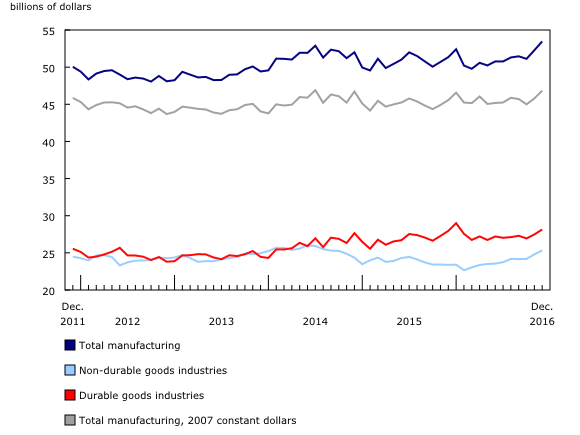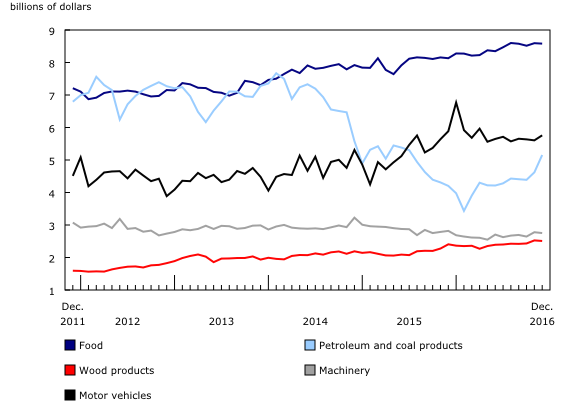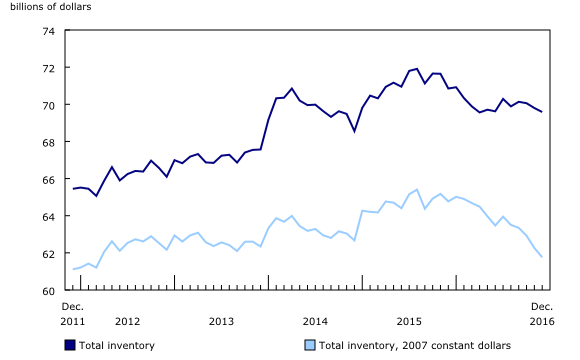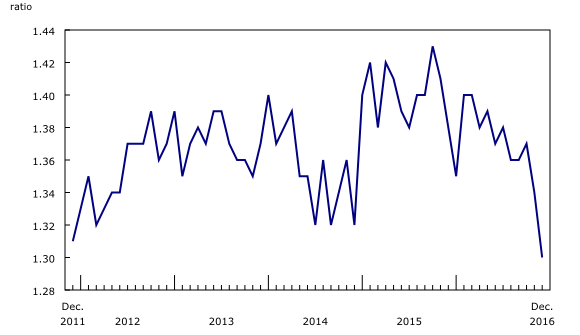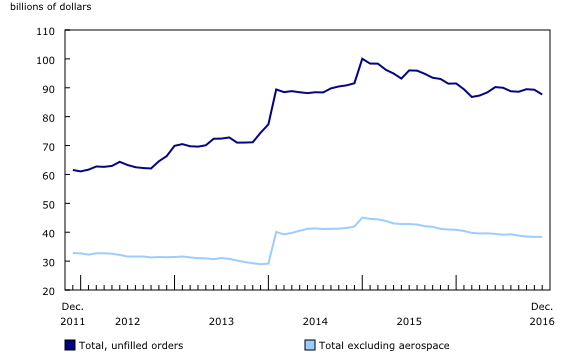Manufacturing: The year in review, 2016
Archived Content
Information identified as archived is provided for reference, research or recordkeeping purposes. It is not subject to the Government of Canada Web Standards and has not been altered or updated since it was archived. Please "contact us" to request a format other than those available.
Released: 2017-03-06
Total manufacturing sales rose 1.0% to $614.4 billion in 2016, following a 1.7% decline in 2015. Higher sales in the transportation equipment and food industries offset declines in the petroleum and coal product industries.
Manufacturing sales reached a record high $53.5 billion in December 2016, largely attributable to a higher volume of goods sold. The previous record of $53.1 billion was set in July 2008, prior to the economic downturn.
Constant dollar manufacturing sales increased 1.3% in 2016, indicating a higher volume of goods sold. Prices in the manufacturing sector declined 0.2% in 2016, according to the Industrial Product Price Index.
Sales of durable goods increase
Sales of durable goods rose for the third consecutive year, up 2.0% to $328.5 billion in 2016. The increase in 2016 was led by the transportation equipment industry and the wood product industry.
Sales of durable goods declined 7.8% from January to March and then increased 5.2% from March to December.
Sales of non-durable goods edge down
Following a 6.1% decline in 2015, sales of non-durable goods edged down 0.1% to $285.9 billion in 2016. The largest contributors to the sales changes in non-durable goods were food manufacturing and petroleum and coal manufacturing.
Sales of non-durable goods, which had been trending downward since July 2014, hit a low of $22.7 billion in February 2016. Sales then grew 11.8% from February to December. The rebound in total manufacturing sales since February 2016 reflected, to a larger extent, gains in non-durable goods manufacturing.
Industry highlights: The transportation equipment and food industries lead the gains
In 2016, 10 of 21 industries, representing 68.8% of the manufacturing sector, reported higher sales.
The transportation equipment industry posted the most important gain in 2016, up 5.8% to $130.0 billion in 2016. Motor vehicle manufacturing sales rose 11.8% from 2015 to $69.5 billion in 2016. In January 2016, recently completed retooling of automotive plants, along with the introduction of more expensive production models, brought motor vehicle manufacturing sales to their highest level since March 2000.
Food manufacturing sales rose for the ninth consecutive year, up 5.3% to $101.1 billion in 2016. Since the current series began in 1992, food manufacturing sales have risen every year except 2005 (-0.8%) and 2007 (-0.1%).
Wood manufacturing sales rose for the fifth consecutive year, up 10.8% to $28.8 billion.
Sales in the petroleum and coal product industry, which began trending downward in July 2014, hit their lowest point in February 2016 at $3.4 billion. Over this period, sales in the industry declined by 52.3%.
However, sales in the petroleum and coal product industry are closely related to oil prices, and with the rebound in prices in 2016, sales increased most months from March through December. Sales in the petroleum and coal product industry reached $5.2 billion in December, their highest level since July 2015 ($5.3 billion).
Machinery manufacturing sales were down for the second straight year, declining 7.1% to $32.0 billion in 2016. Most of the decrease was attributable to lower mining and oil and gas field machinery sales in Alberta.
Sales up in six provinces
Manufacturing sales were up in six provinces in 2016, led by Ontario and British Columbia. Sales edged down in Quebec, while Alberta posted the largest decline.
In Ontario, manufacturing sales rose 4.0% to $300.8 billion in 2016. The gain was mostly attributable to the transportation equipment industry, where sales rose 9.6% to $105.6 billion.
The largest contributors to the sales changes in non-durable goods were food manufacturing, up 5.3% to $40.6 billion, and petroleum and coal manufacturing, down 14.7% to $12.7 billion.
The transportation equipment industry accounted for 35.1% of manufacturing sales in Ontario, while Ontario accounted for 49.0% of total manufacturing sales in Canada in 2016.
Manufacturing sales in British Columbia rose for the seventh straight year, up 4.2% to $45.9 billion in 2016. The increase in 2016 was led by the wood product (+10.3% to $9.5 billion) and the primary metal (+33.0% to $3.4 billion) industries.
In Quebec, manufacturing sales edged down 0.5% to $142.6 billion. Higher sales in the food manufacturing industry, up 5.6% to $23.1 billion, did not offset declines in the transportation equipment industry, down 10.7% to $17.3 billion.
In Alberta, manufacturing sales fell 8.5% to $62.7 billion in 2016. Sales were down in the machinery (-40.9% to $3.6 billion), petroleum and coal product (-12.0% to $12.8 billion) and fabricated metal (-18.7% to $4.3 billion) industries. Excluding these industries, sales in Alberta were down 1.4% in 2016.
Chemical manufacturing was one of the few industries in Alberta with higher sales in 2016, up 6.3% to $13.2 billion, surpassing petroleum and coal sales in the province for the first time since 2004.
The wildfires in Alberta in May forced the evacuation of Fort McMurray and burnt an area about the size of Prince Edward Island. Sales in the petroleum and coal manufacturing industry were down 11.7% in May, but this was expected as maintenance work was underway at some refineries.
There was a 3.8% draw down of petroleum and coal inventories at the national level in May. Overall, however, the effects of the wildfire on manufacturing appear to have been slight and temporary.
Inventories down
The average monthly inventory levels declined 1.5% to $70.0 billion in 2016. Following five consecutive annual increases, average annual inventory levels were at a record high in 2015.
Monthly inventories reached a low in April 2016, rebounded in the summer and then fell towards the end of the year. The decline at the beginning of the year was mostly attributable to lower inventories in the transportation equipment industry.
Constant dollar monthly average inventories fell 1.6% to $63.7 billion in 2016. Constant dollar or volumes of inventories held declined every month in 2016 except January and July.
The annual average inventory-to-sales ratio declines
The annual average inventory-to-sales ratio declined from 1.40 in 2015 to 1.37 in 2016.
After rebounding in February following a low in January, the inventory-to-sales ratio trended downward throughout the year. The decrease was particularly steep at the end of the year, attributable to sales gains in November and December and the continuing decline in inventory levels.
Unfilled orders down, while new orders increase
Unfilled orders decreased 4.1% from December 2015 to $87.7 billion in December 2016. A large portion of unfilled orders was in the aerospace products and parts industry, which tend to be held in US dollars.
Despite the US dollar rising from its April low to a peak in November, monthly unfilled orders tended to decline throughout the year. Excluding the aerospace industry, unfilled order declined 6.2% from December 2015 to $38.4 billion in December 2016.
Constant dollar unfilled orders declined 3.4% from December 2015 to $69.3 billion in December 2016.
New orders in constant dollars increased 6.8% from December 2015 to $46.0 billion in December 2016.
Manufacturing employment declines
Employment in manufacturing decreased 1.0% to 1.7 million workers in 2016, following a slight gain in 2015. Full-time work accounted for 95.5% of manufacturing jobs, while 28.1% of the workforce were women.
Provincially, Ontario (+0.9%) reported the largest employment gain, while Alberta (-17.4%) reported the largest loss.
Nationally, nearly 1 in 10 workers were in the manufacturing sector in 2016, a level relatively unchanged since 2009.
Note to readers
Monthly data in this release are seasonally adjusted and are expressed in current dollars unless otherwise specified. For information on seasonal adjustment, see Seasonally adjusted data – Frequently asked questions.
Non-durable goods industries include food, beverage and tobacco products, textile mills, textile product mills, clothing, leather and allied products, paper, printing and related support activities, petroleum and coal products, chemicals, and plastics and rubber products.
Durable goods industries include wood products, non-metallic mineral products, primary metals, fabricated metal products, machinery, computer and electronic products, electrical equipment, appliances and components, transportation equipment, furniture and related products, and miscellaneous manufacturing.
Production-based industries
For the aerospace and shipbuilding industries, the value of production is used instead of the value of sales of goods manufactured. The value of production is calculated by adjusting monthly sales of goods manufactured by the monthly change in inventories of goods in process and finished products manufactured. The value of production is used because of the extended period of time that it normally takes to manufacture products in these industries.
Unfilled orders are a stock of orders that will contribute to future sales assuming that the orders are not cancelled.
New orders are those received, whether sold in the current month or not. New orders are measured as the sum of sales for the current month plus the change in unfilled orders from the previous month to the current month.
Contact information
For more information, contact us (toll-free 1-800-263-1136; 514-283-8300; STATCAN.infostats-infostats.STATCAN@canada.ca)
To enquire about the concepts, methods or data quality of this release, contact James Brown (613-513-6971; james.brown@canada.ca) or Michael Schimpf (613-863-4480; michael.schimpf@canada.ca), Manufacturing and Wholesale Trade Division.
- Date modified:


